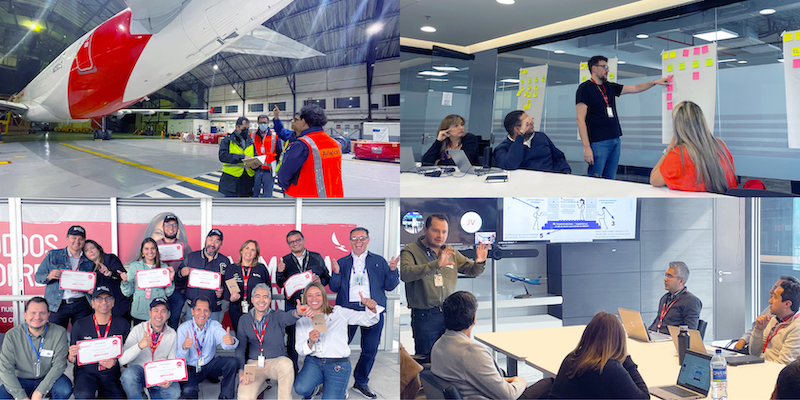
Flying high: Lean Thinking at avianca
INTERVIEW – We speak with avianca’s VP of Maintenance and Engineering to learn about the efforts the airline is making to fulfil its promise to passengers.
Interviewee: Albert Pérez
Roberto Priolo: Can you tell us a little bit about the work of avianca’s Maintenance and Engineering Department?
Albert Pérez: Safety is, of course, our main objective: with our maintenance schedule, we ensure that all components and engines are routinely inspected and that any issue is swiftly addressed. This means responding immediately to any problems that is flagged up, but also – increasingly – trying to anticipate problems using the huge amount of data that we gather from any given flight.
We work to ensure airplanes are available to our passengers day in, day out. This is part of our commitment to take them to their destination safely and on time. This is particularly important to us now: the airline has an ambitious plan of expansion that includes more routes and more frequent connections.
RP: avianca is one of the oldest continuously operating airlines in the world. How do you change a 104-year-old company and why do you think Lean Thinking might just be the way to go about it?
AP: Even before the Covid-19 pandemic, during which all airlines suffered, we had realized that we needed a transformation, and we have been at it for two and a half years already: our current focus is to make flying accessible to everyone (something that Europeans, for example, are more used to, given the presence of established low-cost carriers like Ryanair, Wizzair or Vueling). People want and need to fly, and we are transforming ourselves to make it possible for them to do so.
Of course, changing culture and behaviors in a legacy organization of 14,000 people is not easy, but we believe that Lean Thinking is the perfect approach to make us succeed. There are two main reasons for this. First of all, it allows a culture problem solving to take root, by encouraging people to raise problems, to talk about them, to analyze them and solve them once and for all. Secondly, lean creates accountability by empowering people to take the initiative to solve problems, to challenge the status quo, and to own their work.
These two ideas weren’t widespread at avianca before Lean Thinking came into the picture, and I believe they are the biggest contribution of the methodology to our transformation. The result of our deepening understanding of lean means that we are becoming faster at solving problems, attacking them as soon as they pop up, before they become too big and costly to manage.
I also think that it’s hard for people to change the way they work without a reference and Lean definitely acts like a beacon for us in that sense.
RP: The lean journey of avianca went through a transition of its own, making people more and more aware of the importance of transforming the culture – not just the process.
AP: We have always talked about culture change because we knew that the tools alone couldn’t transform the DNA of our company. It is true, however, that the first phase of our journey was focused on giving people a basic understanding of lean principles and techniques. What we are doing now is trying to develop leadership skills and behaviors to take them to a level where we can effectively support the change we want to see at avianca: we are helping our leaders to visibly change their behaviors and develop new management habits to se the right example. This is the only way to enable lean to take root.
RP: What kind of daily behaviors are you trying to encourage, both at the front line and in leadership?
AP: I can tell you what we are doing with our technicians. We have around 1,000 in our facilities in Bogotá and Medellin and another 1,000 scattered around several other locations. It is their work that really moves the needle! The biggest change in our way of interacting with them is that we are now communicating on a daily basis what’s expected of them. What are their objectives? What does it mean to do the work well? In the past, we talked about strategic objectives, and they struggled to understand how their work could possibly impact those. So, we recently began to translate those company objectives into meaningful indicators and goals they can understand and truly get behind.
This was made possible by the introduction of Daily Management. Now, at the end of every shift, we have a debriefing during which indicators are tracked and discussed. Whenever a gap is identified, someone is made responsible of its resolution, to ensure follow-up.
One of the indicators we track with them is delays. Airplanes will occasionally have “technical problems” – a faulty external light, for example – but that doesn’t mean that the plane has to depart later than scheduled. During the briefings, we discuss with technicians what we can do to ensure that we solve the problem quickly and allow the affected plane to still leave on time. We can put standards in place, for example, to correct the problem right away by leveraging the effective communication flow we have now established in our operations.
What we are still missing is the understanding that the resolution of problems is part of the daily work, not a nuisance or an extra job. It is our responsibility to execute the maintenance schedule, but also deal with any unforeseen circumstances as rapidly as we can. That’s the “step back” we are taking as leaders, to close the gap in the understanding that people have of what their job entails. There is more: as leaders, it is our role to also create problems from time to time, be it because we want to improve the standard or innovate.
RP: With people scattered across different locations, how do you ensure that the same message reaches everyone?
AP: It’s not easy, because the most direct and effective way to change a culture is having leaders directly involved. It is up to them to set the example with their behaviors. As VP of the area, I need to ensure that the 15-20 leaders I have direct and constant interaction with are perfectly align with our strategy to change and that their every-day behaviors and actions will help others to complete that transition as well.
We also have an improvement team that participates in all daily management teams and support the work of leaders by coaching them and providing them with feedback. Those leaders will then go to the gemba every day to make sure the work is being done the way it’s supposed to and to help people with whatever problem they might experience. This is our approach to bring lean to everyone in the department.
RP: How has your day as a leader changed? What have you learned since the beginning of this journey?
AP: I joined avianca two and a half years ago. One of the first things I did was gathering information on how we did things, how we solved problems. We used to have a meeting first thing in the morning with around 150-200 people to discuss what happened the day before and what we could expect for the current day. These meetings often focused on the wrong things. So, leveraging Daily Management, we changed the way we meet: we have a tiered structure of smaller meetings, where indicators are tracked and gaps addressed. The 7AM meeting now takes place at 9:30AM, which gives us the time to develop an understanding of the problems we are experiencing, gather all the information we need, and single out the those we need to give priority to.
I have learned to delegate consciously. I’m always available to go to our hangar and see the work for myself, when it is necessary, but it’s important for the advancement of the organization that everyone tackles the problems they are responsible for. Managers shouldn’t be preoccupied with Type 1 and 2 problems all the time. They can’t only focus on extinguishing fires. That’s why we need to make people accountable and help them to develop a sense of ownership. If we do that, our work as managers can focus on improving things and innovating (Type 3 and 4 problems).
RP: What about the results? What have you achieved so far?
AP: There is nothing more gratifying than seeing that our hard work is bearing fruits. We have already improved the productivity of our technicians by 40%. Technical punctuality has improved by 30% and our airplane availability has more than doubled. In 2019, we had 6-7% of our fleet down for maintenance at any given time, whereas we are now at less than 3%. We still have a lot to do, of course, especially in transforming leadership behaviors. That’s the toughest thing to change!
We are also hoping to involve other parts of avianca in this transformation. Lean change is most effective when it involves everyone in an organization, and we are happy to see increasing interest for the this radically different way of working coming from other areas.
THE INTERVIEWEE

Read more


FEATURE – Is there such a thing as a lean plan? There is, but it's not an off-the-shelf solution that will appease your boss – and that's why traditional, bureaucratic organizations continue to exist.


WOMACK'S YOKOTEN – Effective daily management is still hard to achieve for most organizations. But until line managers start tackling problems first hand as they emerge, rather than deferring and delegating them, basic stability will remain a mirage.


FEATURE – At Malamulele Onward in Johannesburg, a do-it-yourself lean transformation is increasing the impact the nonprofit organization is having on South African children living with cerebral palsy.


OPINION – How many times, in the early stages of kaizen events, have you thought about giving up? Hang in there. As frustrating as they can be, they will also teach you a lot, says our Danish colleague.
Read more


INTERVIEW – The lean journey of the Engineering and Maintenance Department of Colombian airline Avianca proves how important it is for leadership to spearhead change.


FEATURE – In a bid to find inspiration and new ideas to achieve excellent outcomes in patient safety, a group from a Boston hospital flew to Orlando to visit JetBlue Airways.



COLUMN – Last month a video surfaced of a passenger being forcibly removed from an overbooked United Airlines flight and the Internet went ablaze. What does this story tell us about the relationship between profitability and customer value?


INTERVIEW - Having to adapt to changing customer needs, KLM Catering Services decided to turn to lean thinking, reducing its changeover times and recycling more.

